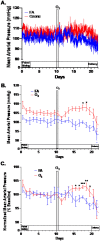This is a preprint.
Characterization of Mild Delayed Gestational Hypertension in Rats Following Ozone Exposure
- PMID: 38464279
- PMCID: PMC10925442
- DOI: 10.21203/rs.3.rs-3977101/v1
Characterization of Mild Delayed Gestational Hypertension in Rats Following Ozone Exposure
Update in
-
Characterization of Mild Delayed Gestational Hypertension in Rats Following Ozone Exposure.Cardiovasc Toxicol. 2024 Sep;24(9):843-851. doi: 10.1007/s12012-024-09887-w. Epub 2024 Jul 4. Cardiovasc Toxicol. 2024. PMID: 38963633
Abstract
The contribution of air pollution induced cardio-pulmonary damage on the development of hypertensive disorders of pregnancy and other adverse outcomes of pregnancy has gained increased attention as epidemiological data continues to highlight spatiotemporal pregnancy trends related to air pollution exposure. However clinical mechanistic data surrounding gestational complications remains sparse, necessitating the need for the use of animal models to study these types of complications of pregnancy. The current study seeks to examine the real-time effects of mid-gestational ozone exposure on maternal blood pressure and body temperature through the use of radiotelemetry in a rat model. The exposure resulted in acute depression of heart rate and core body temperature as compared to control animals. Ozone exposed animals also presented with a slight but significant increase in arterial blood pressure which was perpetuated until term. The data presented here illustrates the feasibility of murine models to assess cardiovascular complications caused by inhaled toxicants during the window of pregnancy.
Keywords: Air Pollution; Hypertension; Ozone; Pregnancy.
Conflict of interest statement
Declarations The authors declare they have no financial conflicts of interest with the content of this manuscript.
Figures




Similar articles
-
Characterization of Mild Delayed Gestational Hypertension in Rats Following Ozone Exposure.Cardiovasc Toxicol. 2024 Sep;24(9):843-851. doi: 10.1007/s12012-024-09887-w. Epub 2024 Jul 4. Cardiovasc Toxicol. 2024. PMID: 38963633
-
Multicenter Ozone Study in oldEr Subjects (MOSES): Part 1. Effects of Exposure to Low Concentrations of Ozone on Respiratory and Cardiovascular Outcomes.Res Rep Health Eff Inst. 2017 Jun;2017(192, Pt 1):1-107. Res Rep Health Eff Inst. 2017. PMID: 31898880 Free PMC article.
-
Early Gestational Exposure to Inhaled Ozone Impairs Maternal Uterine Artery and Cardiac Function.Toxicol Sci. 2021 Jan 6;179(1):121-134. doi: 10.1093/toxsci/kfaa164. Toxicol Sci. 2021. PMID: 33146391 Free PMC article.
-
NTP monograph on the systematic review of traffic-related air pollution and hypertensive disorders of pregnancy.NTP Monogr. 2019 Dec;(7):NTP-MGRAPH-7. doi: 10.22427/NTP-MGRAPH-7. NTP Monogr. 2019. PMID: 33560269 Free PMC article.
-
Ambient air pollution and pregnancy outcomes: A comprehensive review and identification of environmental public health challenges.Environ Res. 2018 Nov;167:144-159. doi: 10.1016/j.envres.2018.07.008. Epub 2018 Jul 5. Environ Res. 2018. PMID: 30014896 Review.
References
-
- Brook R. D., et al. (2010). Particulate matter air pollution and cardiovascular disease: An update to the scientific statement from the American Heart Association. Circulation, 121(21), 2331–2378. - PubMed
-
- Dadvand P., et al. (2014). Particulate air pollution and preeclampsia: a source-based analysis. Occupational And Environmental Medicine, 71(8), 570–577. - PubMed
-
- Pedersen M., et al. (2014). Ambient air pollution and pregnancy-induced hypertensive disorders: a systematic review and meta-analysis. Hypertension, 64(3), 494–500. - PubMed
-
- Wang Q., et al. (2018). Effects of prenatal exposure to air pollution on preeclampsia in Shenzhen, China. Environmental Pollution, 237, 18–27. - PubMed
Publication types
Grants and funding
LinkOut - more resources
Full Text Sources

